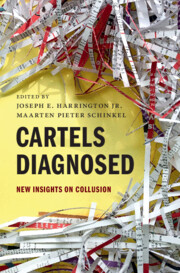Book contents
- Cartels Diagnosed
- Cartels Diagnosed
- Copyright page
- Contents
- Figures
- Tables
- Contributors
- Introduction
- 1 Entry Barriers, Personal Relationships, and Cartel Formation
- 2 “Now You Are Asking for a Real War!”
- 3 Coordinating Fuel Surcharges
- 4 Price Fixing or Fixing Competition?
- 5 The Role of Platforms for Facilitating Anticompetitive Communication
- 6 Collusion with Non-express Communication
- 7 Cartel Instability and Price Wars
- 8 Coordinated Rebate Reductions and Semi-collusion
- 9 Average Bid Auction Format Facilitates Bidding Rings
- 10 The Challenges of Cartelization with Many Products and Ongoing Technological Advancements
- 11 Two Cartels in the Supply Chain
- 12 Is it Collusion or Competition behind Price Parallelism?
- References
7 - Cartel Instability and Price Wars
Retail Gasoline in Canada
Published online by Cambridge University Press: 06 December 2024
- Cartels Diagnosed
- Cartels Diagnosed
- Copyright page
- Contents
- Figures
- Tables
- Contributors
- Introduction
- 1 Entry Barriers, Personal Relationships, and Cartel Formation
- 2 “Now You Are Asking for a Real War!”
- 3 Coordinating Fuel Surcharges
- 4 Price Fixing or Fixing Competition?
- 5 The Role of Platforms for Facilitating Anticompetitive Communication
- 6 Collusion with Non-express Communication
- 7 Cartel Instability and Price Wars
- 8 Coordinated Rebate Reductions and Semi-collusion
- 9 Average Bid Auction Format Facilitates Bidding Rings
- 10 The Challenges of Cartelization with Many Products and Ongoing Technological Advancements
- 11 Two Cartels in the Supply Chain
- 12 Is it Collusion or Competition behind Price Parallelism?
- References
Summary
◦ This case study illustrates the difficulties a cartel can face in getting out of a price war and identifies some of the obstacles to doing so related to market circumstances. It does so by closely examining a price war that upset collusion in Québec City in 2000.
◦ The episode started when an independent retailer chose to defect from the collusive agreement by lowering its price so as to increase sales volume and benefit from a price-support clause it had with an upstream supplier. This act triggered a price war that caused margins to go from five cents per liter to nearly zero and which lasted almost a full year.
◦ Using daily station-level price data, the case study shows the price war lasted so long because it was very costly for any firm to take the lead to return to collusive prices. The root of the problem was the high price elasticity of firm demand. Raising price by only two cents per liter above neighboring prices could result in a 36 percent loss of volume. Thus, a firm raising the price to get out of the price war would experience a significant drop in sales as it waited for other firms to match its increase. This deterrent to raising price was compounded by one of the leading firms having a low-price guarantee which tied its price to the lowest price in the market.
- Type
- Chapter
- Information
- Cartels DiagnosedNew Insights on Collusion, pp. 192 - 221Publisher: Cambridge University PressPrint publication year: 2025
References
- 1
- Cited by

